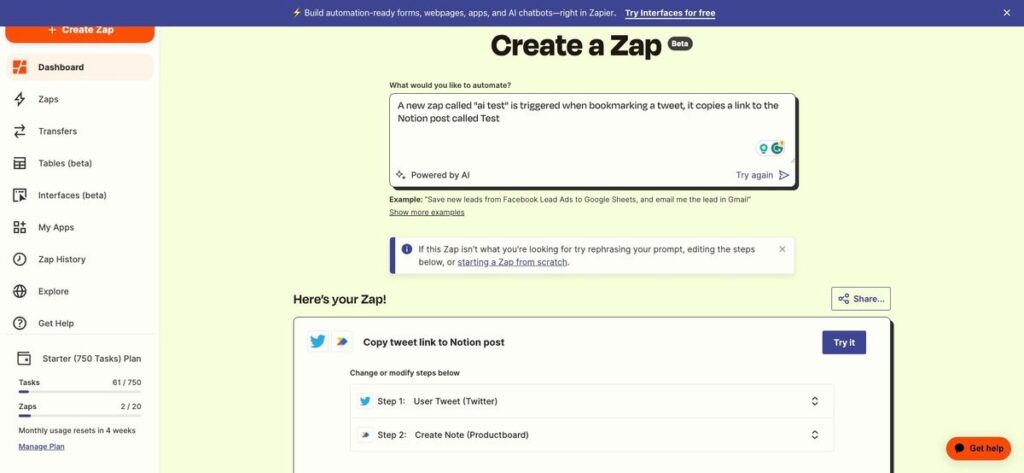In recent months, the landscape of automation tools has been evolving rapidly, with Zapier’s introduction of its AI copilot being a significant development. This feature, currently in beta, aims to streamline the creation of automation workflows—known as Zaps—by leveraging natural language processing capabilities. Understanding this innovation necessitates a comparative framework with other automation platforms, particularly for small to medium-sized business (SMB) leaders and automation specialists who seek efficient, cost-effective solutions.
Zapier’s AI copilot allows users to generate workflows using straightforward text prompts, which lowers the entry barrier for new users and can expedite the setup for seasoned users. For instance, a user might instruct the AI to “save new leads from Facebook Lead Ads to Google Sheets and email me the lead in Gmail,” resulting in automated task generation tailored to specific needs. This capability positions Zapier as a user-friendly choice, especially compared to more complex platforms like Make.
While Zapier excels in ease of use and accessibility, it is crucial to critically analyze the strengths and weaknesses relative to similar offerings in the market. Make, formerly known as Integromat, provides a more intricate visual interface that allows for multi-step scenarios and complex conditional automation. This complexity can be advantageous for businesses that require robust automation but may also pose a learning curve for new users. Moreover, Make supports a wider array of integrations and caters to users who need more customized automation sequences, including event-driven triggers and more detailed data manipulation.
Cost considerations are also pivotal in the decision-making process between these platforms. Zapier’s price tiers are based on task volume, starting from a free plan that allows limited functionalities, escalating to higher tiers for greater usage capabilities and features. Conversely, Make utilizes a credit-based system, where users pay based on the number of operations their scenarios execute, which can lead to cost savings for businesses with fluctuating automation needs. However, for organizations that maintain consistent high-volume automation, the flat-rate pricing of Zapier may provide a clearer financial projection over time.
Moreover, the return on investment (ROI) attributed to these tools is contingent on the specific use cases they serve. Zapier’s strengths lie in its capability to integrate with thousands of apps seamlessly, facilitating quick wins in productivity for businesses that might prioritize quick automation of simple tasks. In contrast, Make’s more powerful features enable businesses to optimize intricate processes, potentially yielding substantial efficiencies in workflow management over the long term. Companies must analyze their specific operational requirements to ascertain which tool aligns best with their immediate objectives and potential for scalability.
Scalability is another critical factor in assessing automation platforms. Zapier’s platform allows businesses to scale operations without significant reconfiguration; as they grow, they can simply upgrade their plans. The inherent flexibility of its AI copilot further supports this scalability, ensuring that both new users and businesses with complex needs can adapt over time. On the other hand, Make may require more robust technical expertise as organizations scale, potentially heightening their reliance on IT professionals to maintain and optimize workflows. This reliance can introduce challenges for SMBs lacking dedicated technical resources.
As automation continues to reshape business operations, comparisons with AI-driven platforms spark important considerations for the future. OpenAI’s advancements in natural language processing present intriguing competition in the automation landscape, particularly for those seeking to enhance customer interaction through conversational AI. Platforms such as Anthropic emphasize ethical AI development, underscoring a different perspective that can resonate with businesses prioritizing responsible technology use. The divergence between enhancing operational efficiencies through automation and fostering responsible AI applications necessitates a careful review by SMB leaders to determine the right balance.
For decision-makers, the implications of adopting an automation platform extend beyond immediate utility. The strategic alignment of technology with business objectives is essential. Investing in a tool that complements existing workflows can translate into both improved productivity and cost efficiency. Nevertheless, leaders must remain cognizant of the need for ongoing training and adaptation among their teams to maximize these tools’ effectiveness.
In conclusion, as organizations work towards achieving greater efficiency and productivity through automation, careful considerations regarding ease of use, cost implications, scalability, and ROI are vital. Different tools cater to varying user needs and business sizes, and leaders must align their choices with their operational realities and future ambitions. The emergence of Zapier’s AI copilot, alongside competitive platforms like Make, OpenAI, and Anthropic, heralds a new era in automation—one where choosing the right tool could significantly impact business trajectory.
FlowMind AI Insight: As automation technologies evolve, businesses must thoughtfully evaluate their tool choices based on specific operational requirements and projected growth. Investing in the appropriate automation platform today can foster resilience and adaptability tomorrow, ensuring that companies remain competitive in an increasingly digital landscape.
Original article: Read here
2023-05-17 07:00:00

